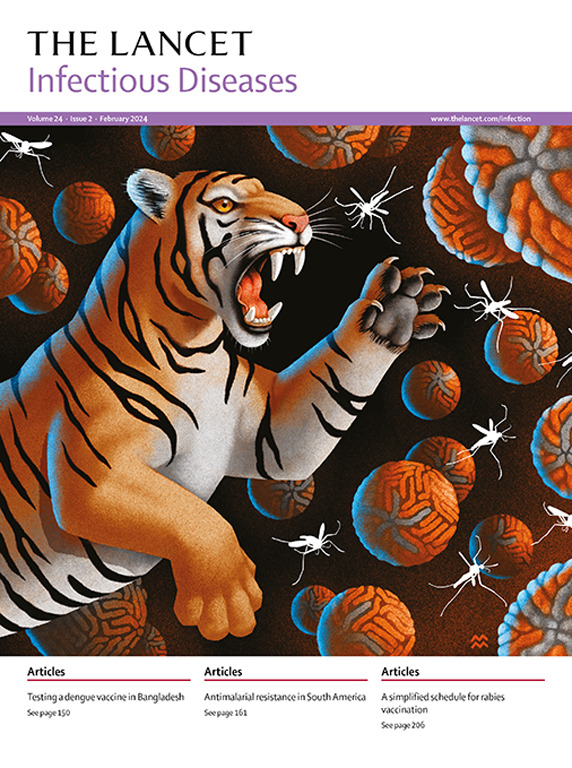The burden of β-lactam allergy labels in health care: a systematic review and meta-analysis
IF 36.4
1区 医学
Q1 INFECTIOUS DISEASES
引用次数: 0
Abstract
Background
Unverified β-lactam allergy labels (BALs) pose a considerable barrier to optimal antimicrobial treatment and represent a growing public health concern. However, no comprehensive meta-analysis has been conducted to explore the associations between BALs and clinical outcomes. We aimed to evaluate existing evidence on the clinical outcomes associated with BALs to determine their global burden.Methods
In this systematic review and meta-analysis, we searched PubMed, the Cochrane Central Register of Controlled Trials (CENTRAL), and Embase from Jan 1, 2000, to Nov 30, 2024. We included observational and interventional studies that compared clinical outcomes related to the presence or absence of a BAL (as reported or documented in any clinical record), irrespective of patient age or clinical setting. The outcomes assessed included the incidence of surgical site infections, the incidence of infections or colonisation due to multidrug-resistant organisms (MDROs) or Clostridioides difficile, mortality, and length of hospital stay. Pooled estimates were calculated using random-effects models, with subgroup analyses conducted by region, country income level, type of BAL, hospital setting, sample size, age group, and quality of evidence. Publication bias was assessed using Begg's funnel plots and Egger's regression test. This study is registered with PROSPERO (CRD42023484030).Findings
63 studies were included in this systematic review, of which 60 (95%) were from high-income countries. Studies were done in the Americas (41 [65%]), Europe (15 [24%]), and the Western Pacific region (seven [11%]). Seven studies were of moderate quality and none were classified as low quality. No significant publication bias was detected for most outcomes, except for length of hospital stay (p=0·0062). Overall, BALs were associated with increased rates of surgical site infection (OR 1·60, 95% CI 1·27–2·01; p<0·0001; I2=70·3%), rates of infection or colonisation with both MDROs (1·42, 1·22–1·64; p<0·0001; I2=84·4%) and C difficile (1·26, 1·16–1·37; p<0·0001; I2=56·4%), and length of hospital stay (standardised mean difference 0·06 days, 95% CI 0·05–0·08; p<0·0001; I2=86·1%). BALs were also associated with death at or after 180 days but not with overall, in-hospital, or 30-day mortality.Interpretation
BALs are associated with an array of adverse health outcomes, especially surgical site infection and infection or colonisation with MDROs and C difficile. Although BALs were associated with longer hospital stays, the observed difference was unlikely to be clinically relevant. The heterogeneity and methodological limitations of the included studies could limit the robustness of some of our conclusions. However, these findings underscore the need to develop and evaluate public health initiatives to curb inaccurate allergy labelling, thereby reducing unnecessary avoidance of first-line β-lactam antibiotics.Funding
National Natural Science Foundation of China.背景未经证实的β-内酰胺过敏标签(BALs)对最佳抗菌治疗构成了相当大的障碍,是一个日益严重的公共卫生问题。然而,目前还没有进行过全面的荟萃分析来探讨 BAL 与临床结果之间的关联。在这项系统性回顾和荟萃分析中,我们检索了 2000 年 1 月 1 日至 2024 年 11 月 30 日期间的 PubMed、Cochrane 对照试验中央注册中心 (CENTRAL) 和 Embase。我们纳入了观察性和干预性研究,这些研究比较了与是否存在 BAL(任何临床记录中均有报告或记录)相关的临床结果,与患者年龄或临床环境无关。评估的结果包括手术部位感染的发生率、耐多药菌 (MDRO) 或艰难梭菌感染或定植的发生率、死亡率和住院时间。采用随机效应模型计算汇总估计值,并按地区、国家收入水平、BAL类型、医院环境、样本大小、年龄组和证据质量进行亚组分析。采用 Begg 漏斗图和 Egger 回归检验对发表偏倚进行了评估。本研究已在 PROSPERO 注册(CRD42023484030)。研究结果63项研究被纳入本系统综述,其中60项(95%)来自高收入国家。研究分别在美洲(41 项 [65%])、欧洲(15 项 [24%])和西太平洋地区(7 项 [11%])进行。七项研究的质量为中等,没有一项研究的质量为低。除住院时间(P=0-0062)外,大多数结果均未发现明显的发表偏倚。总体而言,BALs 与手术部位感染率增加(OR 1-60, 95% CI 1-27-2-01; p<0-0001; I2=70-3%)、MDROs 感染率或定植率增加(1-42, 1-22-1-64;p<0-0001;I2=84-4%)和艰难梭菌(1-26,1-16-1-37;p<0-0001;I2=56-4%)的感染率或定植率,以及住院时间(标准化平均差 0-06 天,95% CI 0-05-0-08;p<0-0001;I2=86-1%)。BALs还与180天或180天后的死亡有关,但与总死亡率、院内死亡率或30天死亡率无关。尽管BAL与住院时间延长有关,但观察到的差异不太可能与临床相关。所纳入研究的异质性和方法上的局限性可能会限制我们某些结论的稳健性。然而,这些发现强调了制定和评估公共卫生措施的必要性,以遏制不准确的过敏标签,从而减少不必要地避免使用一线β-内酰胺类抗生素。
本文章由计算机程序翻译,如有差异,请以英文原文为准。
求助全文
约1分钟内获得全文
求助全文
来源期刊

Lancet Infectious Diseases
医学-传染病学
CiteScore
60.90
自引率
0.70%
发文量
1064
审稿时长
6-12 weeks
期刊介绍:
The Lancet Infectious Diseases was launched in August, 2001, and is a lively monthly journal of original research, review, opinion, and news covering international issues relevant to clinical infectious diseases specialists worldwide.The infectious diseases journal aims to be a world-leading publication, featuring original research that advocates change or sheds light on clinical practices related to infectious diseases. The journal prioritizes articles with the potential to impact clinical practice or influence perspectives. Content covers a wide range of topics, including anti-infective therapy and immunization, bacterial, viral, fungal, and parasitic infections, emerging infectious diseases, HIV/AIDS, malaria, tuberculosis, mycobacterial infections, infection control, infectious diseases epidemiology, neglected tropical diseases, and travel medicine. Informative reviews on any subject linked to infectious diseases and human health are also welcomed.
 求助内容:
求助内容: 应助结果提醒方式:
应助结果提醒方式:


